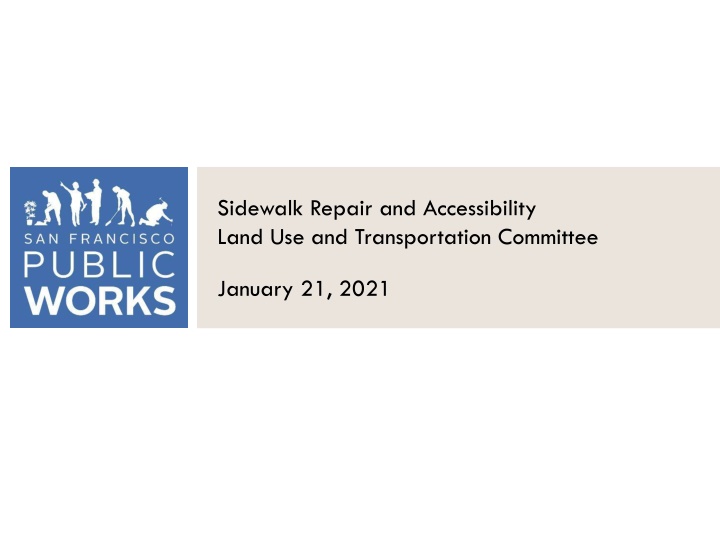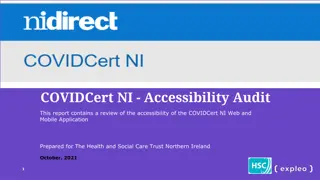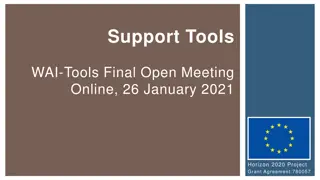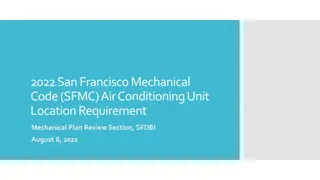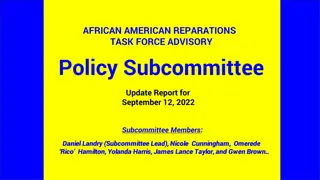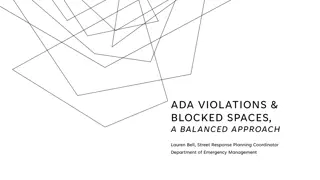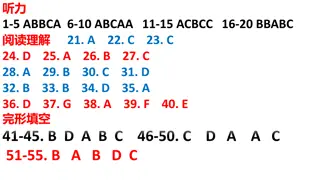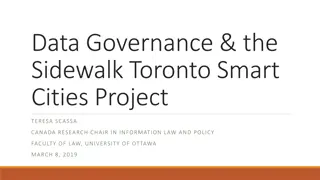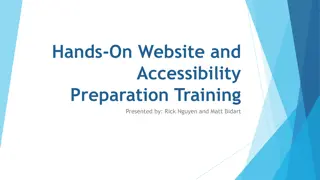Sidewalk Repair and Accessibility Guidelines in San Francisco
Overview of sidewalk maintenance responsibilities for property owners and city agencies in San Francisco, including complaint handling processes, repair timelines, and applicable state and local codes. Property owners are generally responsible for sidewalk repairs, while city agencies have similar responsibilities for the maintenance of adjacent right-of-way areas. Complaints are reviewed promptly, and repairs must be completed within specified timelines to avoid city abatement. Relevant state and local codes govern sidewalk maintenance, liability for unsafe conditions, and regulations for public sidewalk usage.
Download Presentation

Please find below an Image/Link to download the presentation.
The content on the website is provided AS IS for your information and personal use only. It may not be sold, licensed, or shared on other websites without obtaining consent from the author.If you encounter any issues during the download, it is possible that the publisher has removed the file from their server.
You are allowed to download the files provided on this website for personal or commercial use, subject to the condition that they are used lawfully. All files are the property of their respective owners.
The content on the website is provided AS IS for your information and personal use only. It may not be sold, licensed, or shared on other websites without obtaining consent from the author.
E N D
Presentation Transcript
Sidewalk Repair and Accessibility Land Use and Transportation Committee January 21, 2021
Sidewalk-Related Complaints Historically, Public Works accepts 1,200-1,500 complaints each month All complaints directed to the Bureau of Street-use and Mapping (BSM) from 311 are reviewed and either accepted or redirected within one business day. Inspection response times vary between three and five business days Sidewalk and roadway obstructions three business days Sidewalk and roadway defects five business days 1
Responsibilities: Property Owners vs. The City Property owners are responsible for all sidewalk repairs except when: The damage is caused by a City-maintained tree The damage is in the angular return of the sidewalk It s a special instance where the City maintains (Ex. Market Street bricks) The damage is related to a utility Property owners are generally responsible from property line to the curb. For unaccepted streets, they are responsible for maintenance and repair to the mid- point of the street. 2
Sidewalk-Related Complaints Making Repairs In most instances, the timeline for sidewalk-related complaints is 45 days when a private property owner is involved. Initial notice provides 30-day window for repairs to be made. 30 days If defects remain after 30 days, property owners are given 15 additional days to make repairs. +15 days After 45 days, the location will be subject to abatement by the City if defects remain. 45 days 3
Responsibilities: City Agencies and Schools City agencies are treated in the same manner as private property owners and are responsible for the maintenance and repair of the adjacent right of way. The San Francisco School District (SFUSD) is a quasi-state agency and are not responsible for the maintenance and repair of sidewalks adjacent to schools. 4
Applicable State and Local Codes State: California Streets and Highways Code Section 5610 Municipal (Non-exhaustive list): PWC Article 15, Section 706: Owners of Frontage Responsible for Repair Liability for Unsafe Conditions PWC Article 2.4: Excavation in the Public Right of Way PWC Article 5.2: Tables and Chairs in Public Sidewalk or Roadway PWC Article 5.3: Display of Fruits and Vegetables or Nonfood Merchandise on Public Sidewalks PWC Article 5.4: Regulation of Newsracks PWC Article 5.8: Permit Regulations for Mobile Food Facilities Concerning Products for Human Consumption PWC Article 9: Unaccepted Streets PWC Article 15, Section 723: Obstruction of Public Right-of-Way Prohibited PWC Article 15, Section 723.1: Sidewalk Barriers PWC Article 15, Section 723.2: Minor Sidewalk Encroachments Municipal Police Code, Section 63(a): Obstruction of Streets and Sidewalks Regulations: DPW Order No. 178,884: Guidelines for Inspection of Sidewalk Defects DPW Order No. 177,526: Good Neighbor Policy re Repair of Sidewalk Defects 5
Sidewalk Safety Near Construction Sites The City enforces codes that ensure safe and accessible sidewalks surrounding active construction sites. Street Occupancy Permit Required (PWC 724) Material and Equipment (PWC 724) Path-of-Travel and Clearance Requirements (PWC 724) Housekeeping (PWC 724) Defects & Maintenance (PWC 724.2) Construction & Demolition Sites (PWC 724.4) Exceeding Permissible Use or Occupation Without Permission (PWC 724.5) DPW Order 165176 Temporary Occupancy of PROW DPW Order 167840 Guidelines for Placement of Barricades at Construction Sites Regulations Concerning Excavation Sites (PWC 2.4.53) PWC Section 723 Obstruction of the Streets Prohibited 8
Sidewalk Inspection and Repair Program (SIRP) Inspect and repair all the sidewalks in San Francisco on every 25 years Sidewalk damage that is the responsibility of City agencies or private utilities are repaired as part of the program Annual goal to repair 200 blocks and 200,000 square-feet of sidewalk Staffing and annual goals are expected to return to pre-pandemic standards at the turn of the next fiscal year 6
Accelerated Sidewalk Abatement Program (ASAP) Inspects and expedites corrective action for sidewalks that meet certain criteria: Sidewalks in extremely poor condition along residential and commercial throughways. Accessibility-related sidewalk complaints High-priority pedestrian right-of-way sidewalks On sidewalks around City-maintained trees On sidewalks fronting buildings owned by select City agencies 7
Sidewalk Defects Caused by Trees Proposition E went into effect in 2017, transferring responsibility of the maintenance of tree-related sidewalk damage from property owners to Public Works. To-date, Public Works and private contractors have repaired approximately 535,000 square-feet of sidewalks with tree-related damages. More than 40,000 tree-related tripping hazards have been removed by a concrete slicing contractor. 9
Prioritization Process for Tree-Related Repairs The Bureau of Urban Forestry prioritizes tree-related sidewalk repairs by starting with the most damaged sidewalks and those in high-traffic areas. Condition Assessment Prioritize the sidewalks in the worst condition. Start with damaged locations in high-traffic pedestrian corridors and near senior centers, hospitals and bus stops. Targeted Locations Public Works has a contract in place to address smaller uplifts with sidewalk slicing in a more efficient manner than larger uplifts. 11
